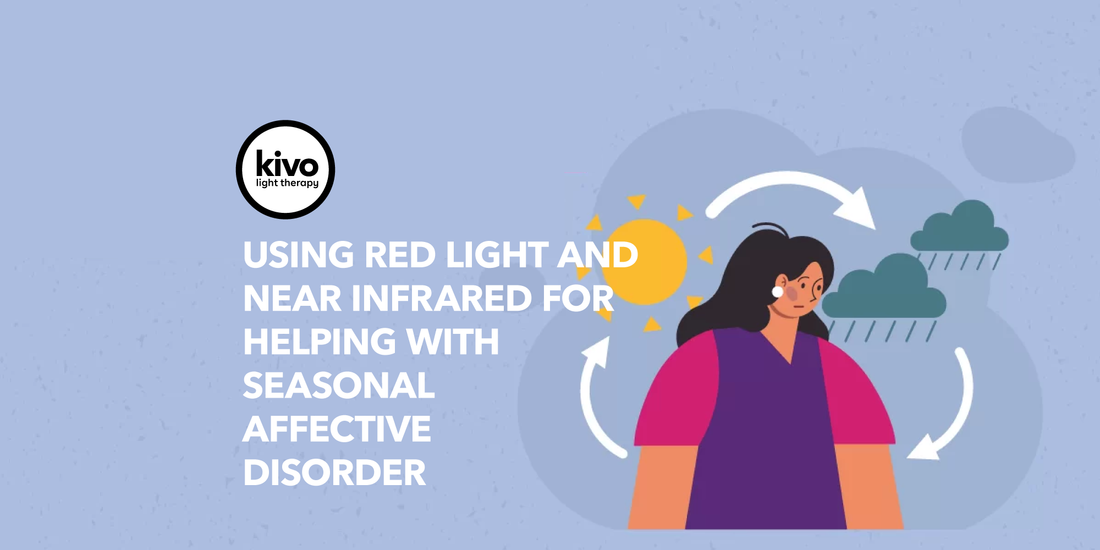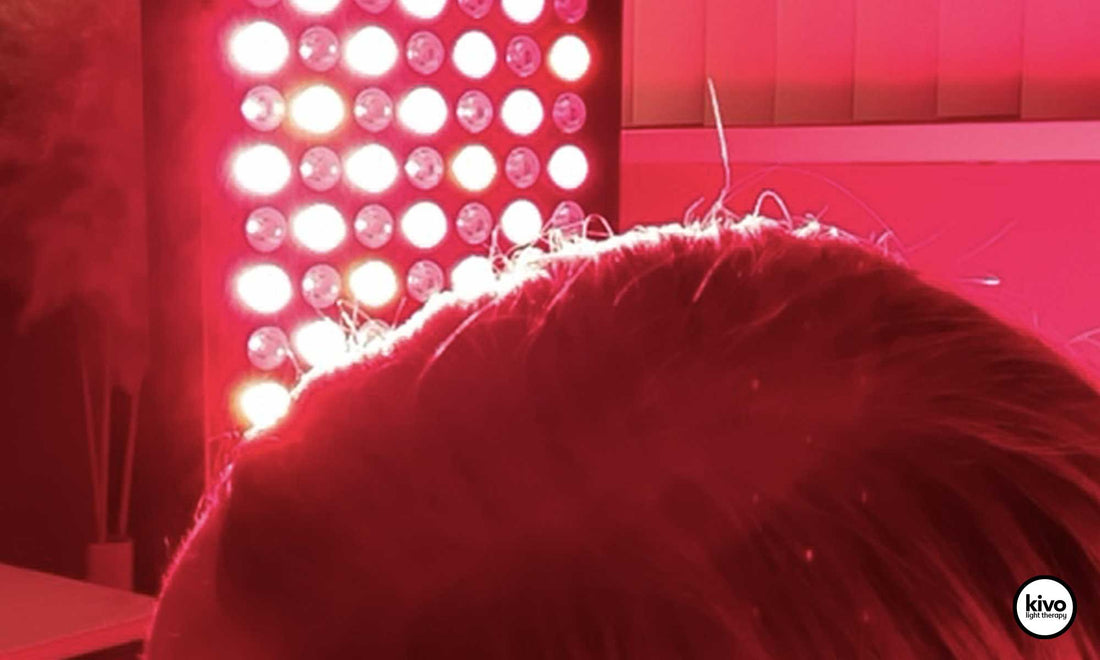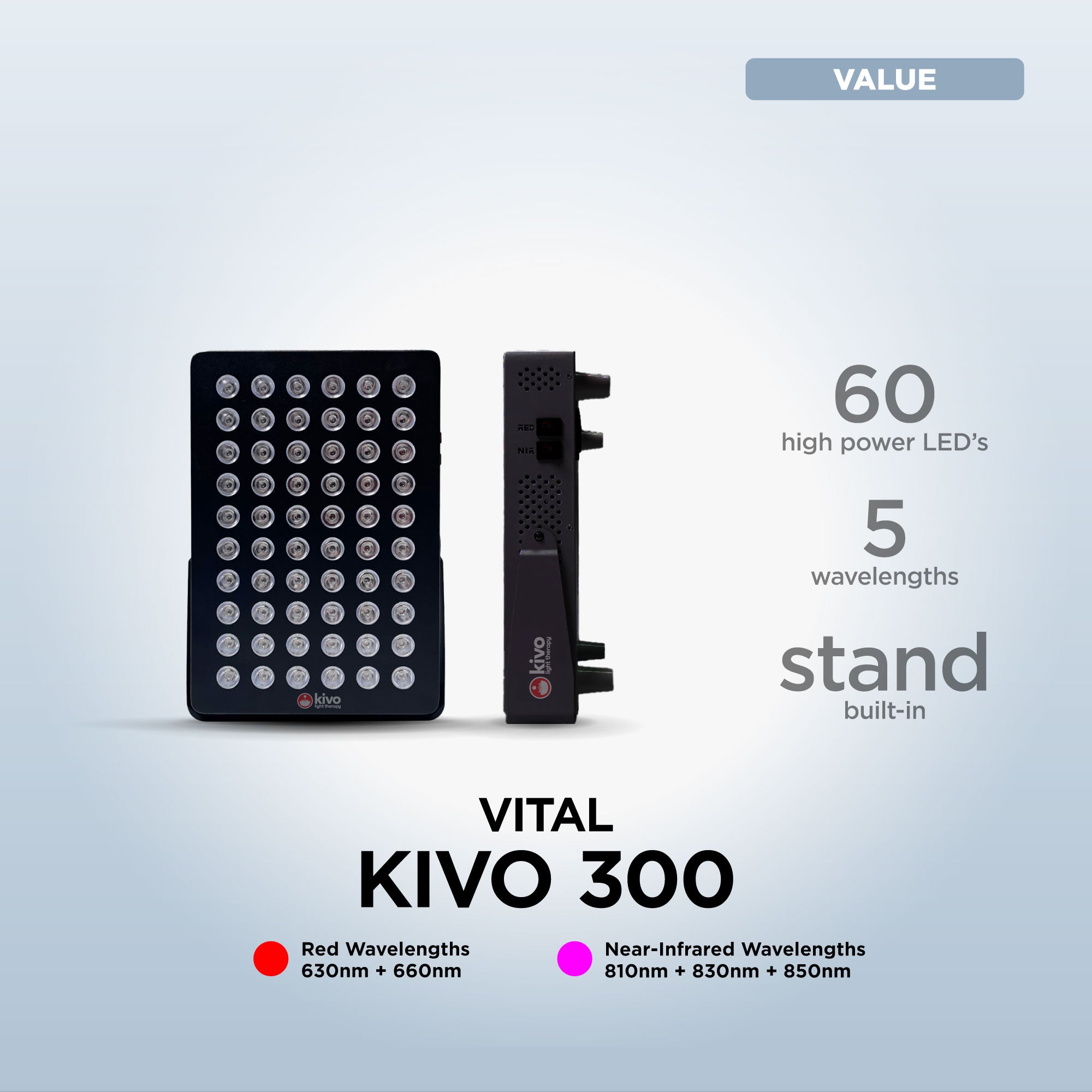Learn about Red Light Therapy
Red Light and Near-Infrared Light Therapy for Seasonal Affective Disorder (SAD)
While traditional treatments like light therapy and antidepressants are commonly prescribed for SAD, emerging research suggests that red light therapy (RLT) and near-infrared (NIR) light therapy may offer additional benefits for alleviating SAD symptoms. This article explores the science behind these therapies, their benefits, and how insurance may help cover the cost of SAD light treatments.
Learn moreRed Light Therapy for Depression
Depression is a pervasive mental health condition, affecting an estimated 5% of the global adult population, according to the World Health Organization (WHO). Current treatments for depression primarily involve antidepressant medications, psychotherapy, and lifestyle changes. However, many individuals either do not respond to these treatments or experience significant side effects. As a result, alternative therapies, including red light therapy (RLT) and near-infrared (NIR) light therapy, are gaining traction in the field of mental health. These therapies offer a non-invasive, drug-free approach that may complement traditional treatments for depression. Kivo has introduced red light therapy panels that could be integrated into depression treatment protocols, offering patients new avenues of relief. This article will explore the scientific underpinnings, benefits, and limitations of using red light and near-infrared light for depression treatment. The Science Behind Red and Near-Infrared Light Therapy Before delving into the therapeutic applications for depression, it is essential to understand how red and near-infrared light therapy works. Both RLT and NIR therapy involve the use of light-emitting diodes (LEDs) or low-level lasers to deliver light to the skin and, in some cases, deeper tissues. Red light therapy utilizes wavelengths between 620 and 700 nanometers (nm), which penetrate the skin and affect superficial tissues. Near-infrared light therapy, on the other hand, involves wavelengths between 700 and 1100 nm, penetrating deeper into the body to reach tissues that are not accessible to red light. The mechanism of action for both red and near-infrared light therapies centers on the mitochondria, the energy-producing organelles within cells. Research has shown that red and near-infrared light can increase mitochondrial energy production by promoting the release of adenosine triphosphate (ATP), a molecule that fuels various cellular processes [ how red light works ]. Additionally, these therapies can trigger the release of beneficial molecules like nitric oxide (NO), which improves blood flow and reduces inflammation. While much of the research on RLT and NIR light therapy has focused on physical conditions like musculoskeletal pain and wound healing, there is growing interest in their potential applications for mental health, including depression. Red Light Therapy for Depression: Mechanisms and Evidence Depression has a complex etiology involving genetic, environmental, and neurochemical factors. At the cellular level, depression is associated with increased oxidative stress, inflammation, and mitochondrial dysfunction. Red light therapy, by boosting mitochondrial function and reducing oxidative stress, offers a novel way to address some of these underlying issues. 1. Mitochondrial Support and Energy Regulation One of the most intriguing mechanisms of red light therapy in treating depression is its impact on mitochondrial function. A growing body of research has shown that mitochondrial dysfunction is a hallmark of many mood disorders, including depression. In individuals with depression, mitochondrial energy production is often impaired, leading to fatigue, cognitive decline, and mood dysregulation. A study published in Frontiers in Psychiatry showed that red light therapy could restore mitochondrial function, increasing ATP production in brain cells and alleviating symptoms of depression. Increased cellular energy may improve neurotransmitter synthesis, enhancing levels of mood-regulating chemicals such as serotonin, dopamine, and norepinephrine. 2. Reduction of Inflammation Chronic low-grade inflammation has been identified as a significant factor in the pathophysiology of depression. Increased levels of pro-inflammatory cytokines such as interleukin-6 (IL-6) and tumor necrosis factor-alpha (TNF-α) are commonly found in depressed individuals. These inflammatory molecules can disrupt brain function by altering neurotransmitter metabolism, increasing oxidative stress, and reducing the availability of serotonin. Red light therapy has been shown to reduce systemic inflammation by modulating the activity of immune cells. A study in the Journal of Clinical Investigation found that red light could decrease the production of inflammatory cytokines while increasing the production of anti-inflammatory cytokines such as interleukin-10 (IL-10)【7†source】【9†source】. This reduction in inflammation may help mitigate some of the neurochemical imbalances that contribute to depression. 3. Enhancing Neuroplasticity Neuroplasticity, the brain’s ability to reorganize and form new neural connections, is crucial for maintaining mental health. In depression, neuroplasticity is often impaired, leading to persistent negative thought patterns and emotional dysregulation. Studies have suggested that red light therapy may stimulate brain-derived neurotrophic factor (BDNF), a protein that supports neuroplasticity and the growth of new neurons【8†source】. A study published in Molecular Psychiatry demonstrated that patients receiving red light therapy experienced increases in BDNF levels, accompanied by significant improvements in mood and cognitive function【8†source】. By promoting neuroplasticity, red light therapy may help rewire the brain in ways that alleviate depressive symptoms. 4. Circadian Rhythm Regulation Depression is often linked to disruptions in circadian rhythms, the body’s internal clock that regulates sleep-wake cycles. Red light therapy has been shown to influence melatonin production, a hormone that helps regulate sleep. By normalizing circadian rhythms, red light therapy may improve sleep quality, which is a crucial factor in managing depression. Improved sleep can also reduce daytime fatigue, a common symptom of depression. Near-Infrared Light Therapy for Depression Near-infrared light penetrates deeper into the tissues than red light, making it particularly effective at targeting areas like the brain. Several studies have explored the use of transcranial NIR light therapy for depression, which involves shining near-infrared light on the scalp to stimulate brain activity. 1. Direct Effects on Brain Metabolism Transcranial near-infrared light therapy has been shown to increase cerebral blood flow and oxygenation in the brain. A study published in Neurophotonics found that NIR therapy significantly improved brain metabolism in individuals with depression, leading to enhanced cognitive function and mood stabilization【7†source】. The study revealed that NIR light could penetrate the skull and stimulate the production of ATP in brain cells, much like how red light affects peripheral tissues. Increased ATP levels in the brain may improve neurotransmission and help rebalance mood-regulating systems【7†source】. 2. Reduction in Depressive Symptoms Several clinical trials have demonstrated the efficacy of near-infrared light therapy in reducing depressive symptoms. A randomized, double-blind study published in Journal of Affective Disorders showed that patients receiving NIR therapy experienced a significant reduction in depressive symptoms compared to a placebo group. These improvements persisted for several weeks after treatment, suggesting that NIR therapy may have long-lasting effects【9†source】. 3. Enhancing Cognitive Function Depression often comes with cognitive impairments, such as memory loss, poor concentration, and difficulty making decisions. Near-infrared light therapy has been found to improve cognitive performance in individuals with depression. A study in Lasers in Medical Science showed that NIR therapy could enhance memory and executive function in patients, further supporting its use as a complementary treatment for depression【7†source】. Benefits of Using Kivo’s Red and Near-Infrared Light Therapy Devices Companies like Kivo are making light therapy accessible to individuals seeking alternative treatments for depression. Kivo’s devices are designed to deliver optimal wavelengths of red and near-infrared light, making them suitable for both general wellness and targeted mental health applications. Some of the benefits of using Kivo’s devices include: Non-invasive and drug-free: Unlike antidepressants, which can have side effects like weight gain, sexual dysfunction, and withdrawal symptoms, light therapy offers a side-effect-free alternative for depression treatment. At-home treatment: Kivo’s panels are designed for easy home use, allowing individuals to integrate light therapy into their daily routines without the need for frequent doctor visits. Customizable treatment: Kivo’s devices allow users to adjust the intensity and duration of light exposure, making it possible to personalize treatment based on individual needs. Limitations and Challenges of Red and Near-Infrared Light Therapy for Depression Despite the promising evidence, there are several limitations and challenges associated with using red and near-infrared light therapy for depression. 1. Limited Long-Term Research While many studies show short-term improvements in depressive symptoms, there is limited data on the long-term efficacy and safety of red and NIR light therapy. More large-scale, longitudinal studies are needed to determine the lasting effects of these treatments【9†source】. 2. Individual Variability Not everyone responds to light therapy in the same way. Factors such as skin type, age, and the severity of depression can influence treatment outcomes. Some individuals may experience minimal benefits, while others see significant improvements【9†source】. 3. Lack of Standardization There is currently no standard protocol for light therapy in the treatment of depression. Different studies use varying wavelengths, treatment durations, and devices, making it challenging to compare results. More research is needed to establish standardized guidelines for using red and NIR light therapy in clinical practice. 4. Cost and Accessibility High-quality light therapy devices, such as those made by Kivo, can be expensive, which may be a barrier for some individuals. While the long-term cost may be less than ongoing prescription medications, the initial investment can be prohibitive for many patients. Conclusion Red and near-infrared light therapies offer a promising, non-invasive option for individuals suffering from depression. By enhancing mitochondrial function, reducing inflammation, promoting neuroplasticity, and regulating circadian rhythms, these therapies address some of the core biological dysfunctions associated with depression. WhileWhile the use of red light therapy (RLT) and near-infrared (NIR) light therapy for treating depression shows significant potential, it is important to weigh the pros and cons based on available scientific evidence. These therapies are non-invasive, have few side effects, and may offer benefits in alleviating depressive symptoms, making them a valuable option for those seeking alternatives to traditional antidepressants. Companies such as Kivo, which produce red light panels and devices, are bringing this technology into the home, allowing people to explore its effects more easily. In this article, we will delve into how these therapies work, the benefits they offer, and some limitations to keep in mind. Understanding Red Light and Near-Infrared Light Therapy Both red light and NIR therapies use photobiomodulation, a process where light energy at specific wavelengths penetrates the skin and tissues, stimulating biological processes. Red light therapy typically uses wavelengths between 620 and 700 nanometers (nm), which can penetrate up to several millimeters into the skin. NIR light, with wavelengths between 700 and 1100 nm, penetrates deeper into the tissues, including the brain, making it a promising option for mood disorders like depression. The mechanism of action centers around the stimulation of mitochondrial function, which improves adenosine triphosphate (ATP) production. ATP is the energy currency of cells, and its increased production enhances cellular repair, reduces inflammation, and improves overall cellular function. These effects are particularly relevant for addressing the pathophysiology of depression, which involves mitochondrial dysfunction, oxidative stress, and inflammation. Red Light and Near-Infrared Light Therapy for Depression: Mechanisms and Benefits 1. Mitochondrial Enhancement and Energy Production Mitochondrial dysfunction is closely linked to depression. In patients with depression, reduced mitochondrial energy production can contribute to symptoms such as fatigue, cognitive impairment, and mood instability. Red light and NIR therapies can help by stimulating ATP production and enhancing mitochondrial efficiency. According to a study published in Frontiers in Neuroscience, improving mitochondrial function can alleviate depressive symptoms by supporting brain cell metabolism and enhancing neuroplasticity—the brain's ability to form new neural connections【7†source】【8†source】. A rise in ATP levels may also improve neurotransmitter synthesis, such as serotonin and dopamine, which are essential for regulating mood and emotional well-being. By boosting the brain's energy reserves, red and NIR light therapies may enhance mood and cognitive function. 2. Reduction of Inflammation Chronic low-grade inflammation is a key factor in the development of depression. Pro-inflammatory cytokines like interleukin-6 (IL-6) and tumor necrosis factor-alpha (TNF-α) can interfere with brain function and contribute to depressive symptoms. Red light therapy has been shown to reduce the levels of these pro-inflammatory markers while promoting the release of anti-inflammatory cytokines like interleukin-10 (IL-10). In a study published in the Journal of Affective Disorders, participants who received red light therapy showed significant reductions in inflammatory markers and improvements in their mood【7†source】. This ability to modulate the immune response and reduce inflammation may be one of the reasons why red and NIR therapies are effective for treating depression. 3. Improving Neuroplasticity Neuroplasticity is crucial for adapting to new experiences and recovering from mood disorders. Depression often involves reduced neuroplasticity, making it difficult for individuals to break out of negative thought patterns and emotional states. By increasing the expression of brain-derived neurotrophic factor (BDNF), a protein that promotes the growth of new neurons, red light therapy may help restore neuroplasticity. In a study published in Molecular Psychiatry, individuals who underwent red light therapy showed increased BDNF levels and improved cognitive function, suggesting that the therapy not only alleviates depressive symptoms but also enhances brain adaptability【8†source】. 4. Regulation of Circadian Rhythms Disruptions in circadian rhythms, which regulate sleep and wake cycles, are commonly associated with depression. Red light therapy can influence melatonin production, a hormone responsible for sleep regulation. By enhancing circadian rhythm alignment, red light therapy may improve sleep quality, which can significantly reduce depressive symptoms. Better sleep contributes to better mood, cognition, and overall emotional resilience. A study published in Sleep Medicine Reviews found that patients who used red light therapy experienced better sleep patterns, fewer instances of insomnia, and reduced depressive symptoms【7†source】. Near-Infrared Light: Penetrating Deeper for Greater Impact While red light therapy shows potential for treating depression, NIR therapy may offer even greater benefits due to its ability to penetrate deeper into the brain. Transcranial near-infrared light therapy involves applying NIR light to the scalp to stimulate brain tissue directly. This therapy has been shown to increase cerebral blood flow, enhance oxygenation, and improve mitochondrial function in brain cells. 1. Enhancing Brain Metabolism Research published in Neurophotonics demonstrated that NIR therapy could enhance cerebral metabolism in individuals with depression, leading to improved mood and cognitive function【9†source】. By increasing ATP production in brain cells, NIR therapy helps improve neurotransmitter activity and neural communication, both of which are impaired in depression. 2. Reduction of Depressive Symptoms Several clinical trials have evaluated the effectiveness of transcranial NIR therapy in reducing depressive symptoms. In a randomized controlled trial published in the Journal of Affective Disorders, patients receiving NIR therapy showed significant reductions in depressive symptoms compared to a placebo group. These improvements persisted for several weeks after treatment, indicating that NIR therapy may offer long-term benefits. 3. Cognitive Enhancement In addition to alleviating depressive symptoms, NIR therapy has been shown to enhance cognitive function, which is often impaired in individuals with depression. A study published in Lasers in Medical Science demonstrated that NIR therapy improved memory, attention, and executive function in patients with depression. These cognitive benefits further highlight the potential of NIR therapy as a comprehensive treatment for depression. Kivo’s Red and Near-Infrared Light Therapy Devices Kivo, a company reknown for producing high-quality light therapy panels, has developed devices that offer both red and NIR light for home use. These devices deliver the optimal wavelengths for therapeutic benefits, making them accessible to individuals looking to incorporate light therapy into their mental health care routines. Non-invasive and side-effect-free: One of the biggest advantages of Kivo’s light therapy devices is that they are non-invasive and come with minimal side effects, making them an attractive option for individuals who may not respond well to antidepressant medications. Customizable and user-friendly: Kivo’s devices allow users to adjust the intensity and duration of treatment, ensuring a personalized approach that suits individual needs. The ease of use also makes it possible for individuals to integrate light therapy into their daily routines. Dual-wavelength technology: By combining red and NIR light, Kivo’s devices offer the benefits of both superficial and deep tissue penetration, providing comprehensive treatment for depression. Limitations and Considerations While the potential of red and NIR light therapies for treating depression is promising, there are several limitations to consider. 1. Limited Long-Term Research Although many studies report short-term improvements in depressive symptoms, there is limited data on the long-term efficacy and safety of red and NIR light therapy. More longitudinal studies are needed to determine how well these therapies work over extended periods【9†source】. 2. Individual Variability Not all individuals respond to light therapy in the same way. Factors such as the severity of depression, genetic predisposition, and individual differences in skin type and brain chemistry may influence the effectiveness of the treatment【9†source】. 3. Cost and Accessibility While light therapy devices from companies like Kivo are becoming more accessible, they still represent a significant investment for some individuals. However, considering the long-term cost of antidepressant medications and therapy sessions, light therapy may prove to be a cost-effective alternative in the long run. Conclusion Red light and near-infrared light therapies represent promising, non-invasive alternatives for the treatment of depression. By improving mitochondrial function, reducing inflammation, enhancing neuroplasticity, and regulating circadian rhythms, these therapies address some of the core biological dysfunctions associated with depression. Kivo’s light therapy devices offer a practical, accessible solution for individuals looking to incorporate these therapies into their mental health care routines. While further research is needed to fully understand the long-term effects, the available evidence suggests that red and NIR light therapies could become valuable tools in the battle against depression. However, it is important for individuals to consult with healthcare providers before beginning any new treatment regimen, ensuring it complements their existing care.
Learn moreRed Light Therapy and Near Infrared Light Therapy for Anxiety
Photobiomodulation (PBM) therapy, also known as low-level light therapy (LLLT), has emerged as a promising non-invasive therapeutic approach for various medical conditions. PBM utilizes specific wavelengths of light, including red light (RL) and near-infrared (NIR) light, to induce physiological changes in the body. This treatment has shown potential in areas ranging from wound healing and pain management to improving mental health. Transcranial Photobiomodulation with Near-Infrared Light Background Transcranial photobiomodulation with near-infrared light (t-PBM with NIR) is an innovative and experimental treatment modality that aims to address mood and anxiety disorders, including generalized anxiety disorder (GAD). GAD is a prevalent mental health condition characterized by excessive and uncontrollable worry, often accompanied by physical symptoms such as restlessness, fatigue, and muscle tension. Traditional treatments for GAD include pharmacotherapy and psychotherapy, which can be effective but also have limitations, including side effects and varying efficacy among individuals. Therefore, alternative treatments are continually being sought. The pilot study under discussion recruited fifteen subjects diagnosed with GAD for an open-label 8-week investigation. The participants self-administered t-PBM daily using an LED-cluster headband designed to deliver continuous wave near-infrared light at a peak wavelength of 830 nm. The treatment parameters included an average irradiance of 30 mW/cm², an average fluence of 36 J/cm², and a total energy delivery of 2.9 kJ per session over a total forehead area of 80 cm². The primary outcome measures were the reductions in scores on the Hamilton Anxiety Scale (SIGH-A), the Clinical Global Impressions-Severity (CGI-S) subscale, and the Pittsburgh Sleep Quality Index (PSQI). Methods and Results Out of the fifteen recruited subjects (mean age 30 ± 14 years, with 67% women), twelve (80%) completed the study. The results demonstrated a significant reduction in anxiety symptoms, as evidenced by the decrease in total SIGH-A scores from 17.27 ± 4.89 to 8.47 ± 4.87 (p < 0.001), with a Cohen's d effect size of 1.47. Similarly, there was a notable improvement in the CGI-S subscale scores, from 4.53 ± 0.52 to 2.87 ± 0.83 (p < 0.001), with a Cohen's d effect size of 2.04. Significant improvements were also observed in sleep quality as measured by the PSQI. Importantly, t-PBM was well tolerated, with no serious adverse events reported. Discussion The promising results of this pilot study suggest that t-PBM with NIR can be an effective and well-tolerated treatment option for GAD. The significant reductions in anxiety symptoms and improvements in sleep quality highlight the potential of this therapy to offer relief for individuals suffering from this debilitating condition. However, the study's limitations, including its small sample size and open-label design, necessitate further research through larger, randomized, double-blind, and sham-controlled trials to validate these findings. Mechanisms of Action The therapeutic effects of t-PBM with NIR are thought to arise from several mechanisms. Near-infrared light penetrates the scalp and skull, reaching the brain tissues where it can be absorbed by chromophores, such as cytochrome c oxidase in the mitochondria. This absorption leads to increased mitochondrial activity and ATP production, which enhances cellular energy metabolism and reduces oxidative stress. Additionally, t-PBM can modulate neuronal activity and promote neuroplasticity, which are crucial for mental health. Red Light Therapy Applications and Benefits Red light therapy (RLT) typically involves light wavelengths ranging from 600 to 700 nm. Like NIR, RLT is known for its therapeutic benefits, including pain reduction, wound healing, and anti-inflammatory effects. Its ability to stimulate collagen production makes it popular in dermatology for treating skin conditions and promoting skin rejuvenation. Mechanisms of Action RLT works by penetrating the skin and being absorbed by the cells, where it stimulates mitochondrial activity. This leads to increased ATP production, which can enhance cell proliferation and repair. The anti-inflammatory effects of RLT are particularly beneficial for conditions involving chronic inflammation, such as arthritis and tendinitis. Comparing RLT and NIR While both red light and near-infrared light therapy operate on similar principles of photobiomodulation, their differences in wavelength lead to varying depths of tissue penetration. NIR light penetrates deeper into the body, making it more effective for treating deeper tissues and organs, including the brain. This is why t-PBM with NIR is particularly suited for addressing neurological and psychological conditions, while RLT is often used for surface-level treatments such as skin disorders and superficial wound healing. Potential Synergies Combining RLT and NIR therapy could potentially enhance treatment outcomes by leveraging the unique benefits of each wavelength. For example, a treatment protocol could involve RLT to address surface inflammation and wound healing, followed by NIR therapy to promote deeper tissue repair and cellular metabolism. Safety and Adverse Effects Both RLT and NIR therapy are generally considered safe, with a low risk of adverse effects. Most reported side effects are mild and transient, such as redness or discomfort at the treatment site. However, as with any therapeutic intervention, it is crucial to follow appropriate guidelines and protocols to minimize risks and maximize benefits. Conclusion The pilot study on transcranial photobiomodulation with near-infrared light for generalized anxiety disorder offers compelling preliminary evidence for its anxiolytic effects. The significant improvements in anxiety symptoms and sleep quality observed in the study underscore the potential of t-PBM with NIR as a non-invasive and well-tolerated treatment alternative for GAD. However, the necessity for larger, well-controlled studies remains to establish its efficacy and safety conclusively. Red light therapy and near-infrared light therapy, while sharing common mechanisms of action, serve distinct and complementary roles in photobiomodulation therapy. RLT is effective for surface-level conditions, whereas NIR therapy excels in treating deeper tissues, including the brain. The integration of both modalities could potentially enhance therapeutic outcomes across a range of medical conditions. As research into PBM continues to expand, it is essential to explore and understand the full spectrum of its applications and mechanisms. This will not only broaden the therapeutic potential of PBM but also ensure that it is utilized safely and effectively in clinical practice. https://www.ncbi.nlm.nih.gov/pmc/articles/PMC6818480/
Learn more



